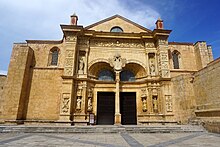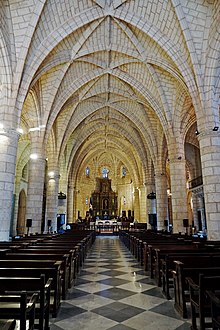| Cathedral Basilica of Santa María la Menor | |
|---|---|
 Front entrance to the Cathedral of Santa María la Menor Front entrance to the Cathedral of Santa María la Menor | |
| Religion | |
| Affiliation | Catholic |
| Province | Archdiocese of Santo Domingo |
| Location | |
| Location | Santo Domingo, Dominican Republic |
| Architecture | |
| Style | Gothic |
| Groundbreaking | 1504 |
| Completed | 1550 |
| UNESCO World Heritage Site | |
| UNESCO World Heritage Site | |
| Part of | Colonial City of Santo Domingo |
| Criteria | Cultural: (ii), (iv), (vi) |
| Reference | 526 |
| Inscription | 1990 (14th Session) |
| Coordinates | 18°28′22″N 69°53′02″W / 18.4727777878°N 69.8838888989°W / 18.4727777878; -69.8838888989 |
 | |
The Cathedral of Santa María la Menor in the Colonial City of Santo Domingo is dedicated to St. Mary of the Incarnation. It is the oldest existing cathedral in the Americas, begun in 1504 and was completed in 1550, and the second constructed, after the Garðar Cathedral Ruins in Greenland. It is the cathedral of the Archbishop of Santo Domingo who has the honorary title of Primate of the Indies because this cathedral was the first diocese and the oldest cathedral established in the New World in the post-Columbus era.
The cathedral is fronted with a golden-tinted coral limestone façade. The building is Gothic, a notable example of real Gothic architecture outside Europe. There is also a treasury which has an excellent art collection of ancient woodcarvings, furnishings, funerary monuments, silver, and jewelry.
It is located between Calle Arzobispo Merino and Isabel la Católica, next to Columbus Park in the city of Santo Domingo de Guzmán.
History

The Cathedral of Santo Domingo is the oldest existing in the Americas, built by order of Pope Julius II in 1504. Headquarters of the Archdiocese of Santo Domingo, its construction began in 1512, under the pastoral government of the first bishop of Santo Domingo, Friar García Padilla, who never came to the island; based on plans by the architect Alonso de Rodríguez.
With the work stopped, they continued with a new design by Luis de Moya and Rodrigo de Liendo in 1522 with the intervention of Bishop Alessandro Geraldini.
The architect Alonso González, inspired by the Seville Cathedral, partially completed the church in 1550.
Successively Alonso de Fuenmayor, promoted the works and on August 31, 1541, it was consecrated.
In 1546 Pope Paul III elevated it to the rank of Metropolitan Cathedral and Primate of America at the request of King Charles V, Holy Roman Emperor.
Another promotion came in 1920 when Pope Benedict XV elevated it to "Minor Basilica of the Virgin of the Annunciation".
In the second half of the 16th century, the Cloister sector was built on the south side, with the cells of the canons; another example is found in the Cathedral of Salamanca in Spain.
In 1547 the work on the bell tower was interrupted, because its height, surpassing the Homage tower, had caused disturbances to the sentinels.
It was the headquarters of the troops of Sir Francis Drake during his invasion of 1586, who sacked it. Apparently in 1665 there was a second consecration.
Initially without chapels, in 1740 it had 9 and currently it has 14. The Chapels of Alonso de Suazo, Rodrígo, Bastídas, Geraldini and Diego Caballero deserve special mention, as well as the crypt of the Archbishops and the lateral Baptismal chapel.
Among the works, the painting of Our Lady of la Antigua, donated by the Admiral. The organ was brought to Magdeburg in 1860.
Description


The architecture of the building of the Cathedral of Santo Domingo is characterized by a Gothic style with ribbed vaults, solid walls and three doors, two of them Gothic in contrast to the third and main of Gothic-Plateresque style.
The cathedral contains a vast artistic treasure made up of altarpieces, paintings (including a panel of the Virgin of la Altagracia dated 1523), old cabinetry, furniture, monuments and tombstones, among other objects. The mausoleums of the archbishops of the colonial period stand out, it is also worth mentioning the tombstone of Simón Bolívar, one of the predecessors of the Liberator.
The remains of Christopher Columbus were housed in the cathedral for a time, which were transferred in 1795 to the Cathedral of Havana and finally, between 1898 and 1899, to the Cathedral of Seville.
The valuable archiepiscopal throne, in the Plateresque style, dates from 1540. It was part of the lower choir, dismantled at the end of the last century to place the marble monument in which the remains of Christopher Columbus were kept.
The cathedral is built with calcareous stone, although some walls are made of masonry and bricks, and it has twelve side chapels, three free naves and a main nave. The roof of the central nave is pitched. Those of the side naves are made up of ribbed vaults that face the outside, as if they were hemispherical domes. The greatest length of the basilica is 54 m from the central nave to the bottom of the presbytery. The width of the three naves is 23 m. The highest height from floor to vault reaches 16 meters, and the built area exceeds 3,000 square meters. Fourteen side chapels were built throughout the cathedral's history.

The surroundings of the cathedral are formulated in three independent spaces, to the north the Plaza de Armas, the battlemented atrium is like an antechamber that marks the main entrance to the religious complex. To the south, the cloister called Plazoleta de los Curas. The annexes around the courtyard allow a passage called Callejón de Curas.
Notable people buried
| This section does not cite any sources. Please help improve this section by adding citations to reliable sources. Unsourced material may be challenged and removed. (June 2021) (Learn how and when to remove this message) |
- Buenaventura Báez – was the president of the Dominican Republic for five nonconsecutive terms.
- Ramón Báez – was a physician and president of the Dominican Republic.
- Fernando Arturo de Meriño – was a Dominican archbishop and served as the president of the Dominican Republic.
- Juan Isidro Jimenes Pereyra – He served as the president of the Dominican Republic.
Gallery
Exterior
-
 Cathedral of Santo Domingo at the late 19th century.
Cathedral of Santo Domingo at the late 19th century.
-
 Coat of arms of the Cathedral of Santo Domingo
Coat of arms of the Cathedral of Santo Domingo
-
 North facade
North facade
-
South facade
-
 North facade
North facade
-
 Main entrance
Main entrance
(west facade) -
 Bell-gable
Bell-gable
-
 (rear) East facade
(rear) East facade
-
 Night view of the main entrance
Night view of the main entrance
-

-

-

-

-
 Roof view of cathedral
Roof view of cathedral
Interior
-
 North nave of Santa María la Menor Cathedral.
North nave of Santa María la Menor Cathedral.
-
 Vaulted ceiling
Vaulted ceiling
(rib vault structure) -

-
 Interior
Interior
-
 Column
Column
-
 Ceiling structure
Ceiling structure
(rib vault) -
 Main altar
Main altar
See also
- List of colonial buildings in Santo Domingo
- Colonial City of Santo Domingo
- Our Lady of Altagracia
- List of oldest buildings in the Americas
- Gothic architecture
- History of the Dominican Republic
- List of basilicas in North and Central America and the Caribbean
References
- ^ "Colonial City of Santo Domingo". UNESCO World Heritage Centre website.
- ^ "Basilica Cathedral of Santa María la Menor". 5albemarleway.co.uk. 15 August 2018. Archived from the original on 26 July 2020. Retrieved 25 September 2019.
- Cardinal Gasparri (1920). "BENEDICTUS PP. XV - LITTERAE APOSTOLICAE - INTER AMERICAE". The Vatican website.
- "Los restos de Colón de la Catedral de Sevilla son auténticos, según los investigadores de Granada". El Mundo. Europa Press. 2006.
External links
- Flores Sasso, Virginia de los Ángeles (2012), Doctoral Thesis about the construction of Santo Domingo's Cathedral (in Spanish).
| Santo Domingo | ||
|---|---|---|
| Topics | ||
- Roman Catholic churches in Santo Domingo
- 16th-century Roman Catholic church buildings
- Roman Catholic cathedrals in the Dominican Republic
- History of the Colony of Santo Domingo
- Spanish Colonial architecture in the Dominican Republic
- Roman Catholic churches completed in 1540
- 1540 in New Spain
- Basilica churches in the Dominican Republic
- Tourist attractions in Santo Domingo
- Gothic architecture in the Dominican Republic
- Ciudad Colonial (Santo Domingo)